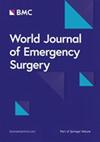Risk factors of 180-day rebleeding after management of blunt splenic injury without surgery and embolization: a national database study
IF 5.8
1区 医学
Q1 EMERGENCY MEDICINE
引用次数: 0
Abstract
This study aimed to identify risk factors for rebleeding within 180 days post-discharge in blunt splenic injury patients managed without splenectomy or embolization. A retrospective analysis was conducted using Taiwan’s National Health Insurance Research Database. Adult patients aged ≥ 18 years with blunt splenic injury (ICD-9-CM codes 865.01–865.09) from 2000 to 2012 were included. Patients who died, underwent splenectomy (ICD-9-OP codes 41.5, 41.42,41.43, and 41.95) or transcatheter arterial embolization (TAE) (ICD-9-OP codes 39.79 and 99.29) on the first admission were excluded. The primary endpoint was rebleeding, which was identified if patients underwent splenectomy or TAE at 180 days after discharge. Multivariate logistic regression was used to identify risk factors, which were validated in a separate cohort. Of 6,140 patients, 80 (1.302%) experienced rebleeding within 180 days. Five significant risk factors were identified: age < 54 years (aOR 3.129, p = 0.014), male sex (aOR 2.691, p = 0.010), non-traffic accident-induced injury (aOR 2.459, p = 0.006), ISS ≥ 16 (aOR 2.130, p = 0.021), and congestive heart failure (aOR 6.014, p = 0.006). We generate Delayed Splenic Bleeding System (DSBS). Patients with > 2 points had significantly higher rebleeding rates (risk-identifying cohort: 2.2% vs. 0.6%, OR 3.790, p < 0.001; validation cohort: 2.6% vs. 0.8%, OR 3.129, p = 0.022). Age < 54 years, male, non-traffic accident-induced injury, ISS ≥ 16, and congestive heart failure are risk factors of rebleeding within 180 days after discharge from treating blunt splenic injury without splenectomy or embolization. Despite limitations, this study underscores large-scale data’s role in identifying risks which can aid clinicians in prioritizing additional interventions during NOM.钝性脾损伤治疗后180天再出血的危险因素:一项国家数据库研究
本研究旨在确定未经脾切除术或栓塞治疗的钝性脾损伤患者出院后180天内再出血的危险因素。本研究采用台湾全民健保研究资料库进行回顾性分析。纳入2000 - 2012年年龄≥18岁的成人钝性脾损伤患者(ICD-9-CM代码865.01-865.09)。排除首次入院时死亡、行脾切除术(ICD-9-OP代码41.5、41.42、41.43和41.95)或经导管动脉栓塞(ICD-9-OP代码39.79和99.29)的患者。主要终点是再出血,如果患者在出院后180天接受脾切除术或TAE,则确定再出血。多变量逻辑回归用于确定危险因素,并在单独的队列中进行验证。在6140例患者中,80例(1.302%)在180天内再次出血。确定了5个显著的危险因素:2岁时再出血率显著升高(风险识别队列:2.2% vs. 0.6%, OR 3.790, p < 0.001;验证队列:2.6% vs. 0.8%, OR 3.129, p = 0.022)。年龄< 54岁,男性,非交通事故性损伤,ISS≥16,充血性心力衰竭是钝性脾损伤未经脾切除术或栓塞治疗出院后180天内再出血的危险因素。尽管存在局限性,但该研究强调了大规模数据在识别风险方面的作用,这可以帮助临床医生在NOM期间优先考虑额外的干预措施。
本文章由计算机程序翻译,如有差异,请以英文原文为准。
求助全文
约1分钟内获得全文
求助全文
来源期刊

World Journal of Emergency Surgery
EMERGENCY MEDICINE-SURGERY
CiteScore
14.50
自引率
5.00%
发文量
60
审稿时长
10 weeks
期刊介绍:
The World Journal of Emergency Surgery is an open access, peer-reviewed journal covering all facets of clinical and basic research in traumatic and non-traumatic emergency surgery and related fields. Topics include emergency surgery, acute care surgery, trauma surgery, intensive care, trauma management, and resuscitation, among others.
 求助内容:
求助内容: 应助结果提醒方式:
应助结果提醒方式:


